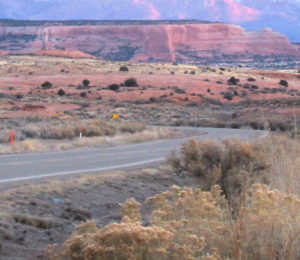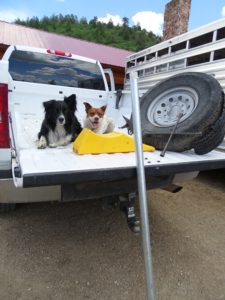I was hauling horses from Utah to Colorado earlier this month. Just south of Moab, Utah, with temperatures in the 90’s, two horses in the trailer, and three dogs in the truck cab, I got a flat.
After 30 sweaty minutes, I was back on the road, but the event prompted a series of “What Ifs” that, in turn, prompted a series of steps to be better prepared when it happens again.
And it will happen again.
That’s the right attitude to assume so that you can be ready and unflustered when it happens.
We have a great check list written by longtime trailer pro, Bobby Fantarella, of Elm City Trailers. Check out the tip list here.
And you can read some cross country travel thoughts and concerns from myself and Mara Miles.
Three additional thoughts to consider:
The Spare:
Most trailers don’t come with spares. Believe me, you do not want to be caught spareless. Spend the extra dough and make sure it’s good to go on every trip.
The Jack:
You do not want to try to jack up your trailer (with or without horses aboard) with a car jack. It likely won’t even work. Carry a drive-on jack like a Trailer Aid, made by Camco.
Swapping tires:
If you’re like me, you might not be able to get machine-tightened lug nuts off the flat. In this recent case, I could only get four of them off. I had to rely on a Good Samaritan with a powerful drill (and the right size bit) . Thank goodness he stopped.
Since then, I carry a simple and cheap solution (instead of buying a power drill and then having to make sure it’s properly charged every time I haul.) A five-foot length of thick pipe. It fits snuggly over the tire iron and increases its leverage. Lug nuts, even those that have been machine-tightened and on the trailer for ages, now come off easily.
Safe travels and happy trails.


Pulled my horse trailer from Anchorage, Alaska to Terrebonne, Oregon and experienced two flats on the horse trailer. Drive on plastic jack did not provide enough clearance. Passing motorist lent a small cheap hydraulic jack that helped raise wheel enough to complete job. In Whitehorse, Canada I bought my own hydraulic jack. The next day had another flat and had no problems changing tire this time. I always carry “cheater” pipe to help with tight lug nuts. Hydraulic jack cost under $20. We also needed orange triangle caution signs to put up as you don’t want to use flares and chance a wildfire starting.
Great comment, Viki. Thanks!
Not sure I made it clear that it was the combination of both jacks that worked. Some people I later learned secure the plastic drive on jack to a 2″ by 12″ board to raise it high enough to get the wheel off. ,.
I had just had my trailer serviced and the shop replaced 3 of my four tires. While I questioned them about that wisdom, they assured me that the 4th was fine. You guessed it, I got a flat on the 4th on my next trip. While I was reading the directions on the drive on jack, a friendly soul stopped to help. The comment on the caution signs is great, off to get two tomorrow. PS..moral of the story: despite professional advice, change all four.
I’m glad everyone is making if safely out of a jam. As for the jack comments, let me help: Some trailers have leaf spring suspension, and some have torsion. Torsion is independent, so you have to get the trailer a little higher to get the wheel off the ground. ‘Trailer Aid’ and similar products work well, but I always like to keep a few pieces of wood with me. Something like two or three 2′ x 6′, about 10″- 20″ long. Also, if you don’t want to purchase an ‘aid’, I cut a ‘wedge’ on a nice thick 6″ x 6″. It doubles as my wheel chock. And if I need extra height, I can slip the 2″ x 6″ under it. I hope this helps!
Great additional tips, Bobby. You’re the best.